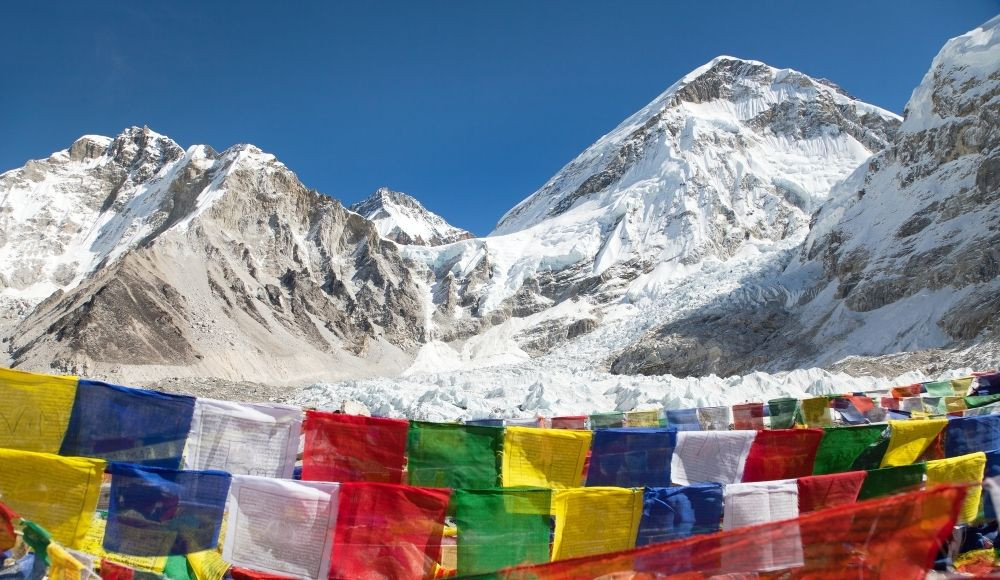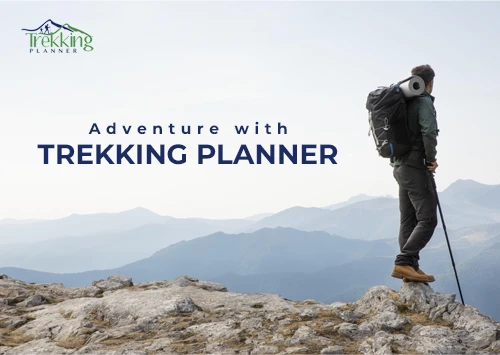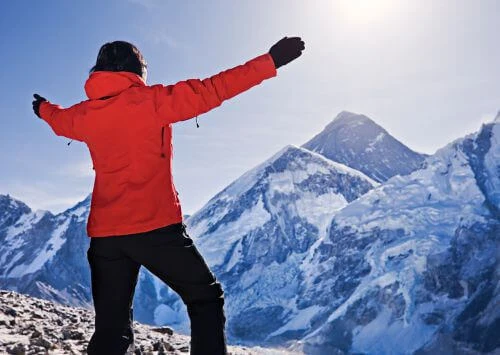Highlights:
- An Adventure to the base of world tallest peaks Mt. Everest and Mt. Lhotse.
- Climb to the highest point of trekking on top rocky Kalapathar Hill at 5,545 m.
- Enjoy glorious panorama of giant Mid-Eastern Himalayan range on daily walks.
- Closest views of Mt. Everest and stunning Mt. Pumori from high Kalapathar top.
- Exciting walks in the harmony of local Sherpa immense culture of Buddhism.
- From lovely green forest of tall rhododendron and pines to arid barren terrain.
Overviews
Everest base camp trekking, one of the most popular adventures around the Himalayan range, for various best reasons. Besides the beautiful scenery of rolling green hills and scenic valleys within the world's highest peaks, is the warm friendly Sherpa hospitality.
Where walks lead to amazing landscapes from green woodland of tall rhododendron, hemlock, magnolia, birch, juniper, pines, and fir trees.
As adventure progress heading towards sheer wilderness within the arid, barren country right beneath towering majestic peaks.
The greatest adventure destination that one choose from all Himalayan and exciting destinations, standing right beneath the world's highest Mt. Everest.
Actually, a base camp of two of the world’s tallest peaks Mt. Everest as well as the world's 4th high Mt. Lhotse. Everest base camp trek includes climbing to Kalapathar Hill, the highest spot of the adventure that offers the closest views of Mt. Everest.

The Trail to Exciting Everest Base Camp Trekking
Everest Base Camp Trek: The route follows a well-established trail through lovely villages adorned with impressive Buddhist prayer symbols.
Lined with a series of Mani walls and prayer spinning wheels, as you pass by around nice villages and farm-land.
The walk begins after a sweeping short flight from Kathmandu to Lukla, then landing at Tenzing Hillary airport. A tribute to legendary mountaineers the first to reach on top of Mt. Everest on 20th May 1953. During air, breathtaking panorama of Central and Eastern Himalayan range with views of Mt. Everest, Mt. Lhotse, and Mt. Makalu. Landing at Tenzing Hillary Airport in Lukla 2,820 m, received by our guide, and then time for a refreshing stop. After getting organized follow the lead guide, as the route follows through Lukla lively town lined with shops, restaurants, and lodges.
On leaving Lukla to enter the main gate of the Khumbu Region, and then downhill past nice villages of Ghai-Kharka. Lovely scenery of well-tended farm fields and terraces growing barley, wheat, and buckwheat are the only high altitude crops grown. As the walk proceeds past Choplung and Ghat villages facing views of Kusum Kanguru, and Kwangde Peaks. Then reaching the first overnight stop at Phakding 2,645 m high, located near Dudh-Kosi River, the main river of Khumbu.
Which is fed from the source of Khumbu and Ngozumba glaciers, the route that we follow in a few days’ time. Spending overnight in Phakding, morning walk on short ups and downhill to Benkar village then crossing a long bridge. Above Dudh Kosi River towards the nice village of Monjo with views of Tharmasarku peak, and then enter Sagarmatha National Park. The name Sagarmatha for Everest in Nepal, while the Sherpa calls Chomolungma of Tibetan origin language, means ‘Great Mother’.
A short downhill to another bridge to cross the same river then reaching the last village Jorsalle before Namche Bazaar. Possible lunch stop before heading to famous Namche Bazaar, a small village located on a gorge with several nice restaurants.
Afternoon walk on river bed covered in a forest of rhododendron and pine trees, as climb takes to cross a bridge. From the last high bridge, uphill on a winding wide path for a few hours having a short stop to admire surrounding views.
As the climb continues facing views of Kwangde, on a clear day view of Everest, Lhotse can be seen on route. Slowly and surprisingly approaching the entrance of Namche Bazaar, the famous town-like village at the height of 3,440 m. A favorite place and major hub of Khumbu Sherpa’s as well for trekkers, where once a week Saturday market held.
Hence the name Namche Bazaar, due to the busy colorful lively Saturday market, is an exciting bazaar to observe.
A perfect and ideal place with the right to spend extra days for acclimatization before heading higher region. Namche Bazaar with various facilities having banks and assist of ATMs, a post office with many shops and well-stocked stores.
Namche Bazaar where houses are lined in an amphitheater, nearly 90 % of big houses serve as lodges, hotels, and resorts. A great place for a rest day with various scenic viewpoints for a side trip before lunch. The nearest best spot walks up to the highest spot of Namche at Park museum.
A place for grand view of Mt. Everest, Lhotse and Ama Dablam with Kantega, Tharmasarku and Kwangde peaks. On this scenic spot visit the Park museum, full of information about the Khumbu Region from local culture, geography, mountaineering history. As well as exotic flora and fauna, the next view spot is the climb to Syangboche with an old short airstrip.
Walk further leads to Everest View Hotel, the first luxury hotel around Khumbu where one can have refreshing drinks. Facing excellent views of Mt. Everest and Ama Dablam, located within beautiful forest surroundings at 3,880 m high.
For energetic people can explore downhill to Khumjung and Khunde villages, located on a glacial valley. Situated beneath towering Mt. Khumbila the holy mountain and patron god of Khumbu Sherpa, after an option to walk further.
Then head downhill with grand aerial views of Namche Bazaar in the backdrop of high towering snow peaks.
After a pleasant time at Namche Bazaar having a rest day and exploring around its scenic hills. The adventure continues towards North-East, a short steep climb, and then on a wide winding trail facing views of snow peaks. A lovely walk maintained by old man Pasang Sherpa, don’t forget to donate in a donation box.
He has been working on making the trail wider for more than two decades and still continues. Walk follows down to Imjatse River and at small place Phungi Tenga, situated amidst a forest of tall rhododendron and pine. A famous spot for a refreshing stop as well for the lunch break, before a big climb of two hours to Tengboche.
Having lunch, afternoon walks uphill within a cool shade of the forest and then slowly reaches on top of a ridge. A small plateau where beautiful, scenic Tengboche and the famous monastery are located, surrounded by high peaks with a view of Everest.
Overnight at Tengboche in one of its many good lodges or a short walk down to Deoboche. After de-tour of the monastery a wonderful interior with beautiful religious paintings, staying overnight at Tengboche or a little further.
The next morning a pleasant walk, after enjoying a grand vista of Mt. Everest and adjoining peaks that surround Tengboche. Walk down to a bridge, then climb to Pangboche village, from here onward tree lines stop for short juniper bush.
Pangboche the last permanent village, from here onwards are temporary settlements at Dingboche, Pheriche, Lobuche, and Gorakshep.
Pangboche with the oldest monastery of the Khumbu Region, which is also on route to Ama Dablam Base Camp. Walk from here on a slow uphill above Imjatse River facing grand close views of towering Mt. Ama Dablam. After Pangboche reaches a small settlement of Somare for a lunch stop, and then continue to walk towards east. On reaching a place where Pheriche and Dingboche route splits, our journey leads east down to a river. As climb reaches a flat area and then enter into a scenic Imjatse valley. Where Dingboche is located at 4,340 m high beneath the North Face of Ama Dablam, facing views of Island Peak towards the east.
Most itinerary days include extra days at Dingboche for proper acclimatization, as well as to explore around this beautiful valley. Dingboche, in early days a summer pasture area for Yaks to graze, with a shelter of cattle herders.
As tourism increased more lodges flourished around Dingboche enclosed by giant peaks within scenic Imjatse valley. At Dingboche side hike to Nakarjung hill a climb of few hours for fantastic scenery of Imjatse valley. Includes awesome panorama of giant peaks as far towards the world’s 5th highest Mt. Makalu with Mt. Lobuche and Mt. Island Peak.
Spending wonderful time at Dingboche, slowly adventure leads higher towards final destination at Everest Base Camp. A short steep morning climb to a ridge festooned with Buddhist prayer monuments and colorful flags. Enjoy the grand vista and then on gradual pleasant up to Thugla with views of Pheriche valley down below. Thugla, a small settlement with tea shops, a lodge where Khumbu Glacier melts into a raging river, a place for a refreshing lunch stop.
The afternoon leads to a steep climb on top Thugla ridge and a small pass at above 4,800 m high. Around this area notice memorials and tombs of unfortunate climbers and mountaineers, from here an easy pleasant walk to Lobuche.
Lobuche, a small settlement tucked in a corner close to Lobuche East and West peaks with grand views of Nuptse. After overnight at Lobuche in the comfort of a nice cozy lodge, the next morning towards the main highlight of the adventure.
Start early for one of the longest walks of the journey, although it is about a 12 km distance from Lobuche. But due to altitude makes the walk tiring and longer begins with an easy gentle pace on a wide valley. As the trek progresses climb leads over rocky moraine above Khumbu glacier, where the route follows with a short steep up to Gorakshep. A wide exposed place located on route Everest and Pumori base camp as to the top of Kalapathar scenic hill. A small settlement with a number of simple good lodges, where most trekkers spend overnights before heading back to Lukla. After completing a walk to Everest base camp and climbing up at Kalapathar hill, Gorakshep was an early Everest Base Camp till the late 1970’s, then extended further about 6 km away from Gorakshep.
At Gorakshep having a refreshing stop, continue walk heading east as the route follows on a gradual path with few short ups. As walk leads over rocky moraine and glacier then reaching beneath world highest Mt. Everest Base Camp. Enjoy the dramatic scenery that surrounds the base camp at 5,364 m high, with close views of the notorious Khumbu Ice-Fall. The base camp is flooded by mountaineering expedition camps in the high climbing season from March till early June.
After a great glorious moment at base camp return journey to Lukla, the final adventure takes you on top of Kalapathar. The highest point of the trek at 5,545 m high faces the closest view of Mt. Everest and Mt. Pumori.
On completing major highlights and achieving the goal of a lifetime experience downhill back into the green forest then reaching Lukla.
For the last overnight stop around the high Khumbu and Everest Region, next, early morning brings you to Kathmandu. After an overwhelming adventure on Everest Base Camp Trekking with one and only Trekking Planner Nepal.
Best Season for Everest base camp trekking.
The best time is from March to May in the spring season, with September until mid-December during the autumn and pre-winter seasons.
From March to May, there are much longer sunlight hours, and green hills with wild flowers, especially rhododendrons of various species, will be in full bloom until Tengboche, making the trek more interesting and very special.
Explore Nepal Trekking Planner's Everest Base Camp Trekking Packages:
Everest Base Camp Trekking: 15 Days
Everest Luxury Lodge Trekking-14 Days






